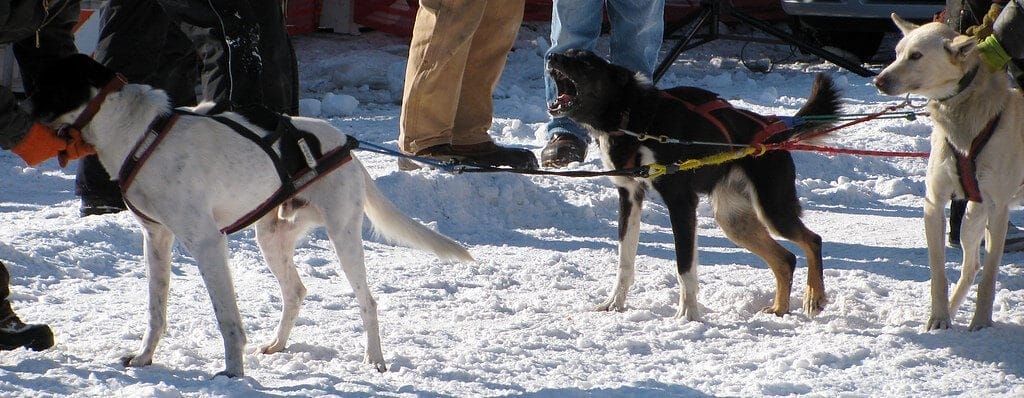Why Do You Need A Dog Harness and Collar? Understanding Your Options
When it comes to picking out walking gear for your four-legged buddy, it’s like choosing between sneakers and loafers for a marathon; both have their place, but one might just edge out the other in terms of comfort and suitability. Considering your dog’s size, breed, temperament, and how the gear fits are crucial steps in making a wise choice. With a variety of collars and harnesses available, from flat collars for the simple and straightforward to harnesses designed to discourage pulling for the more enthusiastic explorers, it’s about finding that perfect balance.
Flat collars are old type of harnesses that are reliable, suitable for dogs that don’t make walking them akin to reigning in a wild horse. Meanwhile, martingale collars offer a bit more control for those who have a little too much enthusiasm. On the flip side, harnesses, especially front-clip ones, provide control for those dogs that haven’t quite grasped the concept of a leisurely walk. Each option has its place, meeting the diverse needs of dog breeds from the laid-back to the spirited.
But it’s not just about control and comfort. Sensitive skin and the dog’s body shape play significant roles in this decision, too. Large-breed dogs might find harnesses distribute weight more evenly, reducing strain on sensitive areas, while dogs with sensitive skin might benefit from rolled collars or limited slip collars that prevent irritation. It’s a mix and match till you find the right fit, ensuring walks are enjoyable for both you and your dog.
The Great Debate: Harness Vs. Collar for Dogs
Jumping into the great debate between harnesses and collars is like entering a battlefield where both sides have their staunch supporters. Harnesses, with their comfortable fit if fitted properly, can offer better control when walking and help prevent strain on sensitive areas and potential respiratory issues. This is particularly true for dogs with a penchant for pulling or those breeds that are prone to breathing difficulties. Collars, while perfect for attaching ID tags and for dogs that walk calmly, might not offer the same level of control or safety for the enthusiastic puller. So, when weighing the options, consider your dog’s health, comfort, and walking habits to make the best choice for your furry friend.
The Case for 
Let’s chat about dog collars for a sec. They’re like the classic tee of the dog gear world; simple, effective, and they get the job done. Perfect for the low-maintenance pup that stays cool, calm, and collected on walks. Collars are great for hanging ID tags and licenses, making sure your dog can be identified if they decide to take an unauthorized jaunt around the neighborhood. Plus, they’re pretty straightforward to use; slip it on and you’re ready to go. It’s about keeping things uncomplicated while still making sure your pup is safe and sound.
Pros
Speaking of collars, they’re kind of the unsung heroes for the easygoing dog. They keep your pooch identified with tags and licenses, because even the best-behaved dog might get a wild hair and take off. Collars are a breeze to put on, making getting out the door quicker than saying “squirrel!” And let’s not forget, they come in every design under the sun, making your dog the most stylish pup at the park.
Cons
But it’s not all walks in the park with collars. For the more… let’s say “enthusiastic”… walkers, collars can put a bit too much pressure on the neck, especially for those prone to pulling. There’s also the risk of slipping out if it’s not fitted right, turning a casual stroll into a heart-pounding chase. And for dogs with sensitive skin, some collars can be like wearing a wool sweater in summer; irritating and just plain uncomfortable.
The Benefits of a Dog Harness
Now, onto harnesses. They’re like the Swiss Army knife of dog walking gear. Ideal for the pullers, the jumpers, and the overly excited, harnesses spread out the pressure, reducing strain on the neck and back. This is a big win for pet owners who worry about their dog’s comfort and safety. Plus, harnesses can help in training, teaching your dog to walk nicely without turning it into a game of tug-of-war. They’re a solid choice for ensuring a pleasant walk for both you and your pup.
Pros
Harnesses shine when it comes to giving pet owners control and keeping their dogs comfy. With the leash attached to a harness, it spreads out the pull, which is way better for your dog’s body. This means less strain on their neck and fewer chances of any respiratory issues. Harnesses can also help discourage pulling, making walks more enjoyable. They’re especially great for puppies, teaching them good walking habits right from the get-go.
Cons
However, harnesses aren’t without their downsides. Some can be a puzzling mix of straps and buckles, turning getting ready for a walk into a mini escape room challenge. And if not fitted right, a harness can rub and chafe, leading to discomfort. Plus, for the escape artist dogs, some harnesses are just a “Hold my beer” away from a Houdini escape, requiring a keen eye on ensuring it’s secure and snug.
How Choosing the Right Type Can Impact Your Dog’s Health
Choosing between a collar and a harness isn’t just about fashion or ease; it’s a decision that weighs heavily on your dog’s health and happiness. The right choice can turn daily walks from a chore into a joy, preventing unnecessary strain on sensitive areas of your dog’s body. Every four-legged friend is unique, and recognizing their specific needs can lead to happier, healthier lives. Whether it’s a gentle stroll around the block or a brisk walk in the park, the comfort and safety of your dog should always take the front seat. Keep this in mind, and you’re on the right track to fostering a loving and healthy relationship with your pet.
The Health Implications of Traditional Collars
In the world of traditional collars, not all that glitters is gold. Sure, they’re straightforward and practical for identification, but they can pack a punch in the health department. Particularly prong collars and their ilk, which, let’s be honest, can be a bit medieval for your modern-day pupper’s needs. These types of collars apply pressure directly on the neck, a sensitive spot that doesn’t take kindly to unnecessary strain or choking. It’s worth considering how often your dog might pull and the potential for long-term effects, because let’s face it, no one wants to see their furry buddy uncomfortable or in distress.
Why Body Harnesses Might be a Healthier Choice for Some Breeds
Let’s talk body harnesses. They wrap around your doggo like a hug, distributing pressure evenly across the chest and shoulders instead of just the neck. For breeds with a delicate throat or those experts in the art of pulling, a body harness can prevent potential throat damage and keep that pesky tracheal collapse talk off the table. It’s like choosing sneakers over high heels for a marathon; it just makes sense. And hey, for those canines that think they’re Houdinis, a harness is a bit more escape-proof, keeping your furry friend safe and sound by your side.
Training and Behavior: Collar or Harness?
So, you’ve got a collar and a leash in one hand, a harness in the other, and a dog that’s more excited than kids on a sugar rush. What’s the move? While collars are the go-to for hanging IDs and rabies tags, when it comes to training and everyday walks, you want to weigh your options. A harness can offer more control and reduce the risk of injury, especially if your pup is a puller or a jumper. It’s about using the right tool for the job—keeping your doggy safe and making your walks a breeze, not a battle.
The Role of Harnesses in Training and Reducing Pulling
Ever seen a dog in a harness, pulling like they’re trying to win a tug-of-war championship? Some folks think harnesses encourage pulling, but that’s like saying spoons make you fat. Dogs pull because they’re excited, not because a harness makes them. A good no-pull harness can actually teach Fido manners on the walk, gently discouraging the pull without hurting their throat or back. It’s about guidance, not restriction, turning those chaotic walks into peaceful strolls. Plus, harnesses are like a gentle hug with every step, and who doesn’t like hugs?
Can Collars Be Effective Training Tools?
Collars are the old-school choice for training, sort of like the vinyl records of dog training tools. They’re classic, straightforward, and, when used right, can be effective in teaching your pooch the fine art of polite leash walking. Fastening the leash to a collar can make it easier to get your dog’s attention for corrections and cues. Just remember, it’s all about how you use it—gentle guidance, not tugging or pulling that could turn a lesson into a wrestling match. And always, check that it’s snug, but not too tight, like a properly fitted watch.
Types of Dog Harnesses and Their Specific Uses
Walking your dog shouldn’t feel like a workout session gone wrong. There’s a science to picking the right harness, kind of like finding the perfect pair of shoes. You want to consider your dog’s size, breed, and the unique traits that make them, well, them. Big or small, chill or full of energy, there’s a harness that fits every personality. It’s about making walks enjoyable, whether you’re strolling through the park or navigating busy sidewalks.
Back Clip Harnesses: Ideal for Gentle Walkers
Got a dog that walks like they’re in a parade, all regal and composed? A back clip harness is what you’re looking for. It’s the equivalent of a casual stroll, with the D-ring on the back providing a stress-free walk for both you and your furry friend. Just a heads up, if your buddy has more pep in their step and likes to lead, this might not be your best bet. It doesn’t do much for pullers, but for the calm walker, it’s a match made in heaven.
Front Clip Harnesses: The Solution for Pullers
Now, for the enthusiastic explorers who can’t help but pull, the front clip harness is your secret weapon. Attaching the leash to the dog’s chest flips the script—it’s like trying to pull against a force field that gently nudges them back towards you. It’s a game-changer for training, teaching dogs that pulling just isn’t worth it, all the while keeping their neck and spine as happy as a clam. For dogs who pull, this style of harness can be the breakthrough you’ve been hoping for.
Step-In Harnesses: Ease of Use for Owners
If the thought of dressing your dog in a harness is more daunting than assembling IKEA furniture, step-in harnesses might just be your saving grace. Lay it down, have your pooch step into it like they’re entering the stage, fasten it up, and voilà—you’re ready to go without any wrestling matches. It’s perfect for dogs that aren’t a fan of overhead motions or for owners looking for a hassle-free setup. Who said convenience and comfort couldn’t go hand in hand?
Dog Breeds and Their Best Match: Harness or Collar?
Finding the perfect match for your dog’s walking gear is like swiping right on the most compatible companion—it’s gotta be the right fit. From the neck-sensitive greyhounds to the sturdy, compact French bulldogs, every breed has its quirks. Some might be prone to neck injuries or conditions like tracheal collapse, making a harness not just preferable, but necessary. Others might do just fine with a collar, especially if it’s more about carrying ID tags than actual walking gear. It’s all about understanding your dog’s needs and making sure they’re comfy and safe, no matter the choice.
Considering Size, Age, and Breed Specifics
When it comes to finding the right walking gear for your dog, think of it as tailoring a suit – one size does not fit all. The pint-sized toy breeds to the majestic giants, the young pups to the senior doggies, each has different needs. A harness can protect against neck injuries and tracheal collapse, especially important for those breeds that might be more vulnerable. And when it comes to leash attachment, it’s about hitting the right spot that keeps them comfortable and in control. After all, every dog deserves to walk in style and safety, no matter their shapes and sizes.
Personalized Recommendations for Your Dog
When it’s time to decide between a collar and a harness for your pup, think about a few key things: how big your dog is, what kind of breed they are, their personality, and the overall fit. You wouldn’t slap any old shoes on for a run, right? It’s the same deal for your four-legged friend. The right choice makes all the difference, whether you’ve got a tiny terror that could slip out of a collar or a brawny beastie that needs a bit more guidance and support.
The Long-term Benefits of Choosing Wisely
Choosing the right gear for your dog isn’t just a one-and-done deal. It’s about keeping them healthy and happy for the long haul. A well-matched harness or collar can prevent injuries and discomfort, ensuring your walks together are nothing but a joy. After all, a happy dog on a walk makes for a happy human. So, taking the time to find the right fit isn’t just good for your dog – it’s a win-win for both of you.
Enhancing Your Dog’s Well-being Through Proper Selection
Every caring dog owner wants what’s best for their furry companion. That’s why selecting the right walking aid is more than just a choice; it’s an expression of love. By opting for the right harness or collar, you help prevent unnecessary strain on sensitive areas of your pup’s body. Prioritizing their comfort and health not only makes walks safer but transforms them into enjoyable adventures for both of you. If in doubt, chatting with your vet can steer you towards the best option, giving you peace of mind knowing your dog’s well-being is looked after.
The Connection Between Comfort, Health, and Behavior
Got a dog, you’ll want a well-fitting harness that lets your buddy move freely and doesn’t mess with their natural stride. A Y-shaped harness does the trick by lining up nicely with their breast-bone and keeping those shoulder joints free to move. Plus, when the leash attaches at the back, it’s like magic – your dog feels free as a bird. This setup is good news for behavior too, cutting down on that dreaded leash aggression. It’s more than good looks; it’s about giving your pup the freedom to be their best self.
Owners’ Tales: Real Experiences with Harnesses and Collars
While collars might be the old school go-to for doggie ID and restraint, thanks to their simplicity and affordability, not to mention the plethora of styles, they’re not always the top pick for every pooch. Some owners have noted that training methods that involve a bit of tug at their leash can sometimes put undue pressure on the blood vessels and neck of their furry companions. But, there are plenty of options out there, finding the right fit means you can avoid potential snags and keep your best bud comfy and secure.
From Persistent Pullers to Calm Companions: Success Stories
Transforming a dog that loves to lead into a calm companion is no small feat, but with the right guidance and gear, it’s more than possible. Hearing tales of the journey from relentless tugging to peaceful strolls is not just inspiring, it’s a testament to the power of patience and finding the right harness or collar. It’s these stories that light up the path for fellow dog owners navigating the challenges of leash training.
Lessons Learned and Tips Shared by Experienced Dog Owners
Gleaning wisdom from those who’ve walked the path before can save you time, energy, and even a few leash burns. The best dog owners are the ones ready to listen, learn, and adapt. Whether it’s understanding the importance of the right gear or mastering the art of calm, consistent training, every shared experience is a nugget of gold worth its weight. These insights aren’t just helpful, they’re a lifeline for making the journey with your four-legged friend the best it can be.
Making the Right Choice for Your Furry Friend: A Summary of Insights
Finding that sweet spot between a doggie fashion statement and the primo functional choice for walks ain’t always a walk in the park. When we talk harnesses and collars, it’s all about knowing your pup. Some dogs can easily slip out of a collar faster than you can say “Squirrel!” For the little escape artists, a harness might keep them snug as a bug. But hey, let’s not forget about puppy training, where a simple collar might do the trick. It’s like picking the right tools for a job—every dog’s different.
At the end of the day, whether you go Team Collar or Team Harness, it boils down to your furry friend’s well-being. It’s key to understand that what works for one dog might not be the answer for another. Sizes, breeds, and even a dog’s age can tip the scales. The goal? Making sure your four-legged buddy is as comfortable as going barefoot in the park, with their health and happiness leading the charge. After all, picking the right gear is a step toward many happy strolls together.













